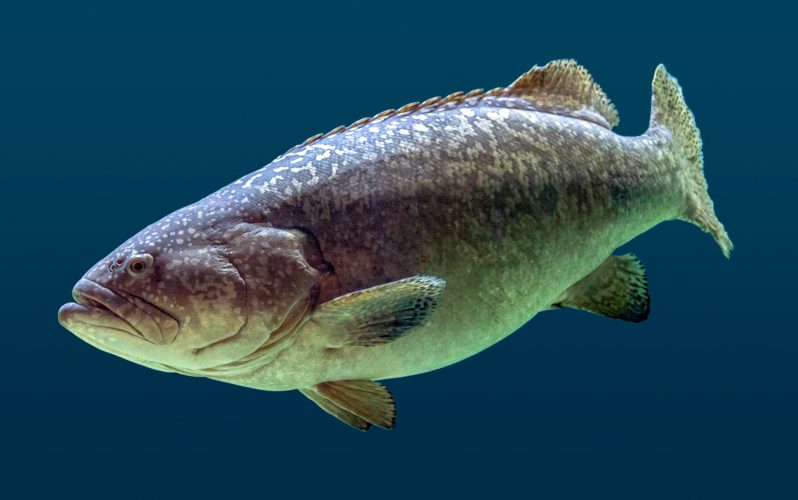A Warsaw Grouper is exclusively a member of the genus Epinephelus, and it has 10 dorsal backbones. The Warsaw grouper’s second spine, or second backbone, is much longer than the third. It is an elongated second dorsal spine. The Warsaw grouper has a greyish brown color with various tiny, uneven white eruptions on its sides.
The color of the grouper is often much lighter around the nape and along the rear margin of the operculum. The color of the fins of a Warsaw grouper is dark brown, but a white splotch color characterizes the dorsal fin. The young Warsaw groupers have a yellow caudal fin, a dark bridle on the caudal peduncle, and some whitish specks on their bodies.
The Warsaw Grouper is widely distributed all over the world. The species lives in a distinctive part of the underside, crevices, gorges, and drop-offs, found in the continental shelf break in waters 350 to 650 feet deep. Other species that live in this efficient deep-water region are frosty and lustrous edge groupers, tilefish, and silk snappers.
The Warsaw grouper has existed for a long time; it is long-lived. Its feet reach up to 6 feet and over 300 pounds. It has a gigantic mouth that enables it to swallow prey whole. The color of the Warsaw grouper is light speckled when it is viewed around the neck and the back edge of the gill. The entire fin is dark brown, except for the white-splotched spiny segment of its dorsal fin.
Scientific Classification of The Warsaw Grouper
| Species Name: | Hyporthodus Nigritus |
| Species Family | Serranidae |
| Species Sub-family | Epinephelinae |
| Species Kingdom | Animalia |
| Species phylum | Chordata |
| Species Class | Actinopterygii |
| Species Order | Perciformes |
| Species Genus | Hyporthodus |
| Species Habitat | Nearshore, Reef, Deepwater |
| Species Weight: | 150 – 440 pounds |
| Species Length | 65″ – 92″ |
| Species Feet | 6ft |
Warsaw Grouper (Hyporthodus Nigritus)
The Warsaw grouper is a species of fish found in the Western Atlantic Ocean. It belongs to the Serranidae family. The Warsaw groupers are mostly based in the southwestern region of Florida, near the Gulf of Mexico, and south of Brazil.
The Size of The Warsaw Grouper
The Warsaw grouper is a variety of fish with listless development that can exist for as long as 41 years. Their full size is 7.7 feet in length and 430 pounds in weight. The world record for the biggest Warsaw grouper ever captured in Florida was 436 pounds.
Is Warsaw grouper good for food?
The Warsaw Groupers come behind the Goliath Groupers in terms of their large size. They are the second largest fish family. When it comes to food, the smaller the size of a Warsaw grouper, the tastier it is. It is widely believed that the tinier Warsaw grouper is better for food because of its good taste.
Why is it called the Warsaw Grouper?
It is called a Warsaw grouper because of its large size. It is a type of giant grouper that lives in deep waters. Warsaw Groupers are another giant fish found in the deep ocean and can grow up to seven feet.
Is Warsaw Grouper the Same as Goliath Grouper?
No, they are not the same. Although they are both giant groupers, they do not live in the same habitat and do not possess the same characteristics.
Interesting Facts About Warsaw Groupers
- They are protogynous hermaphrodites, i.e., they start their lives as females, and only mature, large fish change into males. They change their sex when they need to reproduce but are naturally born as females.
- The young Warsaw groupers live near the ocean’s shore, and fishermen easily capture them for food because of their tasty characteristics.
- Apart from the Goliath Grouper, the Warsaw Groupers are the second largest in the grouper family.
- The smaller the Warsaw grouper, the tastier it is. The smaller-sized groupers are good for food. The bigger ones may inhibit parasitic worms and possibly cause Ciguatera poisoning.
- They are the only giant fish with10 dorsal spines.
- The Warsaw groupers have a world record of 436 pounds.
- They gather in large numbers to breed.
- Warsaw groupers are slow-growing species and are late to develop.
- Overfishing can quickly unnerve the distribution of males to females in the community and eliminate too many of the older, bigger grouper before they have the opportunity to propagate young ones.
- They swim in abysses of 80 to 1,300 feet, but the adult Warsaw groupers are vastly found between 200 and 400 feet. The young ones live in surface waters.
What Do the Warsaw Groupers Feed On?
The giant Warsaw groupers have a large mouth that enables them to feed on their prey by swallowing them whole. They eat lobster, crabs, shrimp, fish, and other sea foods. The Warsaw Grouper are more inclined to swallow their prey rather than chew them.
How Can One Capture a Warsaw Grouper?
The Warsaw groupers are most desirable because of their large size, and every fisherman dreams of catching them. However, the giant groupers have enormous surely, and they have the strength to fight and overpower any fishermen if the fisherman isn’t strong enough. You must use a great angler and a nice hook and prepare for the battle ahead.
To capture a Warsaw grouper, you can use baits such as halved bonito, whole fish, squid, and any other slash pieces of bait. You can also use bridling bait to catch a Warsaw. The best method to capture a Warsaw grouper are still-fishing and drifting. Warsaw Groupers are captured on underside apparatuses allured with squid or cut pieces of fish.
Where Do Warsaw Groupers Live?
Warsaw Groupers live in drop-offs, crevices, hollows, and rocky undersides on the continental shelf with a profundity of 350 to 650 feet. The small ones are occasionally found on shallow-water reefs and docks.
Conservation Of the Warsaw Grouper
Hyporthodus nigritus is a critically endangered species, and this endangering reduces its mortality (due to stress). It is listed on the IUCN red list as “Near Threatened,” and the American Fisheries Society lists it as an Endangered Species. Warsaw groupers are extremely vulnerable to overfishing because of some of their distinct natural characteristics.
Conclusion
The Warsaw grouper is widely distributed all over the world. The species lives in a distinctive part of the underside, crevices, gorges, and drop-offs, found in the continental shelf break in waters 350 to 650 feet deep. Other species that live in this efficient deep-water region are frosty and lustrous edge groupers, tilefish, and silk snappers.
Warsaw grouper has existed for a long time; it is long-lived. Its feet reach up to 6 feet and over 300 pounds. It has a gigantic mouth that enables it to swallow prey whole. The color of the Warsaw grouper is light speckled when it is viewed around the neck and the back edge of the gill. The entire fins are dark brown, except for the white-splotched spiny segment of its dorsal fin.
Warsaw grouper ranges from Massachusetts to the Gulf of Mexico, Cuba, and Trinidad, all the way down the coast of South America. The Warsaw grouper is one of the largest groupers on the surface of the water, and it amounts to eight feet and 440 pounds. It is an isolated, deep-water fish that favors depths of 228 to 660 feet.












Pingback: Differences Between a Grouper and Lingcod | Reel Fishing Guru